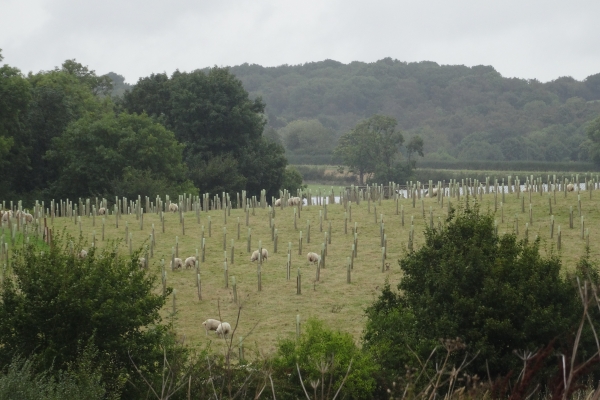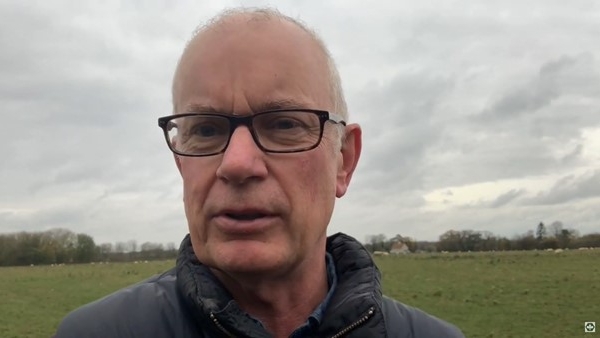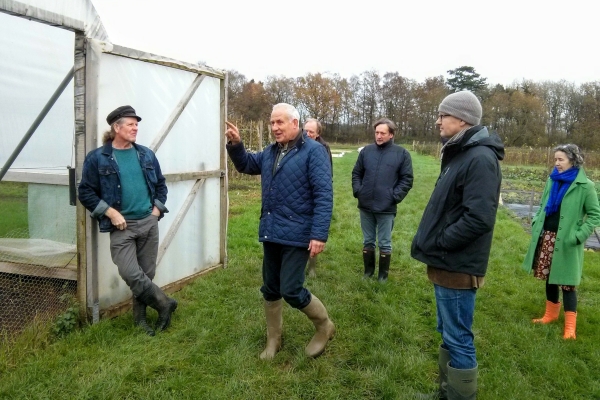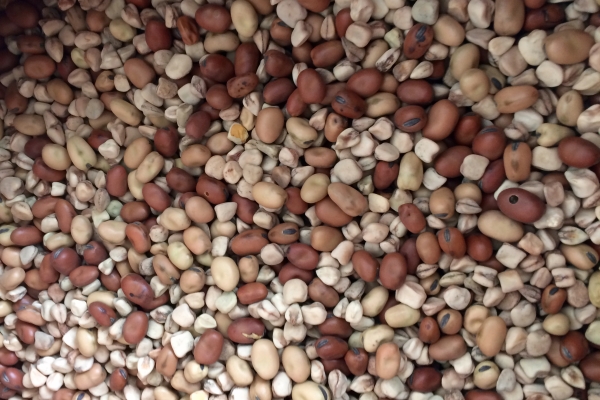Pawsey Family & Team at Shimpling Park Farm
Shimpling Park Farm
Shimpling Park Farm is a 700 hectare (ha) mixed organic farm situated about 8 miles south of Bury St Edmunds in Suffolk. Myself (John), my wife Alice, who deals with all the sheep sales, the building rentals and the diversification bits of the business, and our son Rufus, currently work alongside a fantastic team of three other farm workers (Sam, Charles and Andrew), and a full-time shepherd (Joe). We also have an amazing team in the office with Amanda and Wendy.
We manage our farm as a whole farm system under the Government approved organic certification body OF&G. We grow a range of combinable crops including milling oats for White’s Oats through Organic Arable, some novel crops i.e. spelt, heritage wheat, quinoa, chia, and lentils, and a range of herbal and fertility leys. We have 1,000 New Zealand Romney sheep which graze our two-year grass and clover leys. The sheep are mainly sold locally by Alice to local markets i.e through box schemes and local butchers. We also mill some of our own flour which is sold to local bakers. We have about 160 ha of leguminous and herbal leys across the farm, which are instrumental in increasing soil health, biodiversity and nature.
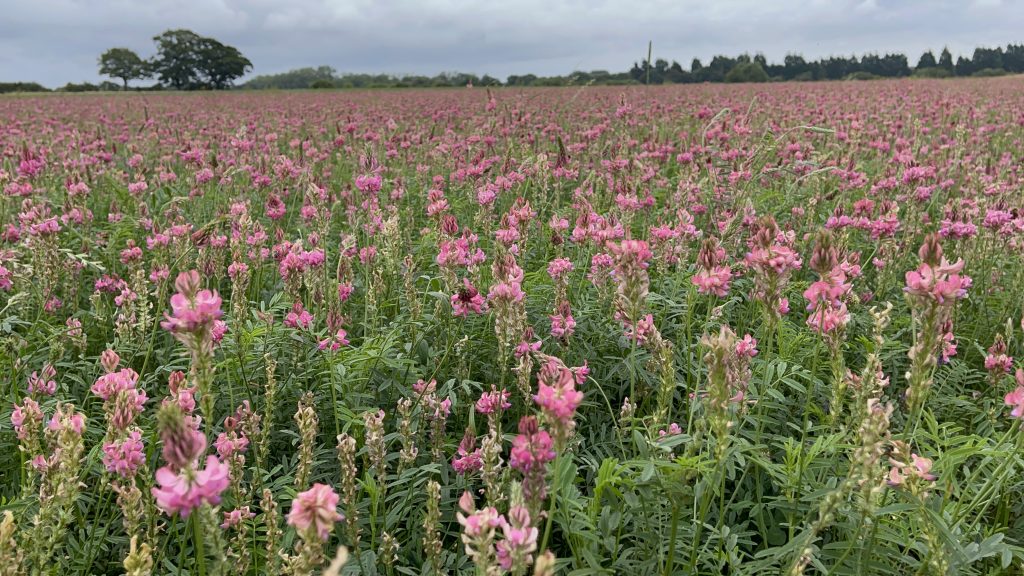
Rufus is making big strides in developing his role on the farm, and at the moment is focusing on day-to-day bits and pieces and the trials that we do. Because we’re farming quite a lot of land, our current direction (for everyone) is to really focus on the detail, giving ourselves the time and space to find out what is working in terms of growing crops whilst simultaneously enhancing nature on the farm, which is a big driver. We do various on-farm trials every year; looking at everything from impacts of different seed rates and effects on yield, to weed and disease control. Anything that people offer us, we will give it a go and try! We are doing increasingly more multi species cropping in terms of bicropping, green manures, and under sowing of crops.

We are fully engaged in a blended SFI Countryside Stewardship Scheme (CSS) with a focus on landscape restoration, farmland birds and education, and in a landscape recovery pilot at the moment, through the Suffolk Wool Towns cluster. We started the cluster about 5 years ago. With the landscape recovery scheme, we are looking at connecting ancient and secondary woodlands over 20,000 ha, so it’s a big project. Through a previous CSS, we restored various farm ponds as well as two medieval moated sites, replanted hedges which had been formerly removed, coppiced ancient woodland, and restored some of the medieval wood pasture at Shimpling Park.
We host over 25 school visits very year and entertain a similar amount of farmer groups, either going on farm walks or having conferences / meetings at Shimpling Park (the use of our barn has expanded!).
We conduct regular bird surveys, one concluded “The 17-year history of organic management at Shimpling Park appears to favour and encourage a stronger farmland bird community or at the very least may have prevented the declines experienced in areas dominated by intensive management.” The reversal of our declining arable bird species on the farm is something that we are particularly proud of.
We have a photovoltaic array on our grain store roof which offsets the electricity used by our electric grain drying fans. We have three woodchip boilers which are fed entirely from the wood coppice from our ancient woodland which is in the middle of the farm. We also rent out a number of buildings to local businesses on a former USAF airfield at Lavenham. The field is the home of the USAF 487th Bomb Group.
Find out more about Shimpling Park Farm in this short video (published in August 2023):
Sustainability in practice
Controlled Traffic Farming
We have developed a Controlled Traffic Farming (CTF) system on our fields with the aim of reducing tractor wheelings and therefore compaction on our soils. Inspiration came from Tim Chamen from CTF Europe Ltd. More can be found out about CTF on their website.
Essentially CTF means tractors run on the same track every time they enter a field treating the untracked part of the field like a bed never to be run on. This has obvious consequences of less compaction, better plant root development and optimum yield. We are seeing the benefits of more even crop growth, consistent and deeper rooting structures, better water infiltration and more earth worms.
The main challenge was coming up with the track width which would be future proof. In the end we decided on an 8.8m system and all our field implements fit into that track width apart from our combine harvester.
Agroforestry
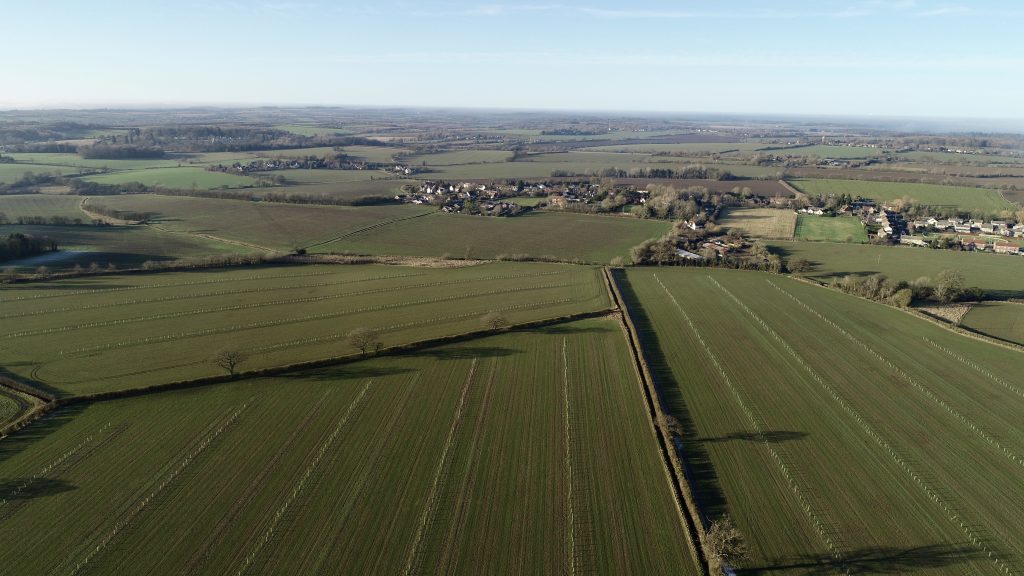
Very much inspired by agroforestry pioneer Martin Wolfe, we could see the huge benefits to be gained from agroforestry such as enhanced farm biodiversity and creating a perennial income alongside the annual crop. Martin’s sad passing gave me the impetus to stop thinking about it and just get on with it! We have now planted aspen, black poplar, common, alder, common walnut, field maple, goat willow, hazel, holly, hornbeam, pedunculate oak, rowan, small leaved lime, wild cherry, and wild service. They’re basically replicating the trees that can be found in the farm’s Alpheton Wood, our SSSI wood. They are being grown for timber and coppicing purposes but also to manage for wildlife, drawing species out of the nucleus of wildlife that can be found in Alpheton Wood into the farm landscape, and very much with an emphasis on sympathetic management. We plan to do this over a long period of time so that when we replant, it’s not going to be a clear fell situation; the replanting will complement, and it will all be managed. Trees like cherry will come out after 50 years, oak after 150 years. It will hopefully make for a very diverse ranging system. When considering the cropping and tree alley width, we had to make sure we maximised on the efficiencies and productivity of the 8.8 m-controlled traffic system.

The trees were planted as 30 cm whips in 1.5 m tubular tree guards. The intention is to extend the agroforestry, but we’ve had a lot of problems with deer – part of our landscape recovery project is looking at deer control. In this country we have to cull 40% of our population just to stand still… until we get the deer controlled on the farm, we won’t be planting any more trees. We have been experimenting with mulching around the base of some of our trees with sheep’s wool. Alice also went to the local hairdressers and got bags of human hair which she has been putting down the tubes around the trees, and is supposed to put the deer off. Not a lot of difference has yet been observed. Somebody also suggested to us that we should go to the local zoo and get some lion poo! Even though deer haven’t come across lions for a long time, it’s in their psyche!
In the video below, John describes the agroforestry implemented. In December 2020 they planted 3 fields totalling about 50 acres with 3,500 trees that mimic the species in the adjacent SSSI woodland and are ideally suited for the farm soil type. Between the trees they are growing organic arable crops (cereals and pulses) and graze their sheep. The trees are planted in lines in the fields at 36 m intervals, with 4 m wide alleys. John talks about what inspired him, the reasons behind some of the practical decisions, how they plan to use and manage the trees and expected benefits; for livestock, people, wildlife and the environment. This was produced as part of ‘A National Networks of Agroforestry Farms’ project. Find out about it here. Access a quick reference summary here: Agroforestry at Shimpling Park Farm.pdf
Find out more detail about the tree species planted and early practical considerations by watching this farm diary video made in December 2020 when they first started planting the trees.
View more footage of agroforestry at Shimpling Park Farm in this video filmed at OF&G’s NOCC21. It features Woodland Trust outreach adviser Jonny Ball talking about management of trees on the farm, the many ways in which trees can benefit your farm and farm business and, crucially, important points to consider when embarking on an agroforestry project; from determining whether or not there is a market for what you want to grow to whether your land is actually appropriate for planting trees… He also gives some guidance on the all-important question of who is going to pay for it…. Jonny explains some of the grant schemes available via the Woodland Trust. You can find out more here.
Farm System Health
The one thing that we’ve really majored on in relation to the health of the farm is we have invested a huge amount of time in the people that make up Shimpling Park Farm team. We’re very much now empowering every individual member of staff to champion their own bit of what they do for our business. For example, Sam, who is doing the sowing of the seeds and the harvesting alongside us, very much drives the harvesting plan, selection of varieties, and any trials we may want to do, and everyone is charged with similar responsibility. Our approach is very much along the lines of if you want to do it, we are listening, and we will work with you to do it, or you can go off and do it yourself. We’ve invested a huge amount of time in listening to people and working out what’s important to them – is it about just having the freedom of the farm in their free time or is it about focusing on more technical issues, / understanding the data better…? We have regular meetings where everyone has a platform to demonstrate or show something or try to take us in a different direction. The only thing I insist on is that I buy everybody tickets to Groundswell – we go as a team every year and set up a Shimpling Park Farm campsite! I feel it’s our spiritual home in terms of ambition, and everyone buys into that.
Last year (2023), we didn’t have a great time in terms of profitability because it was a poor harvest and low prices, but we’ve got the best team that we’ve ever had because we invested a huge amount in them. If you’re coming into times of change and the business needs to change, you can do that so much easier with an engaged team.
John took part in the ‘Farm System Health in Practice’ project – which you can find out about here. In the video below he gives us some insight into the principles of how he achieves health on his farm and how he relates his practices to the 10 principles of health defined in the project:
Reintegrating Sheep with Arable
Reintroduction of sheep onto the farm for us felt like the right thing to do given that we were cutting and mulching fertility leys with a tractor and mower and wanted to do it with animals, and we had been getting a grazier with a flying flock in to do it, which felt out of control as he wasn’t really keeping a close eye on the detail in terms of weeds etc. So we wanted to take that back in hand and felt that animals had something to offer, as they have done for hundreds of years on mixed farming systems.
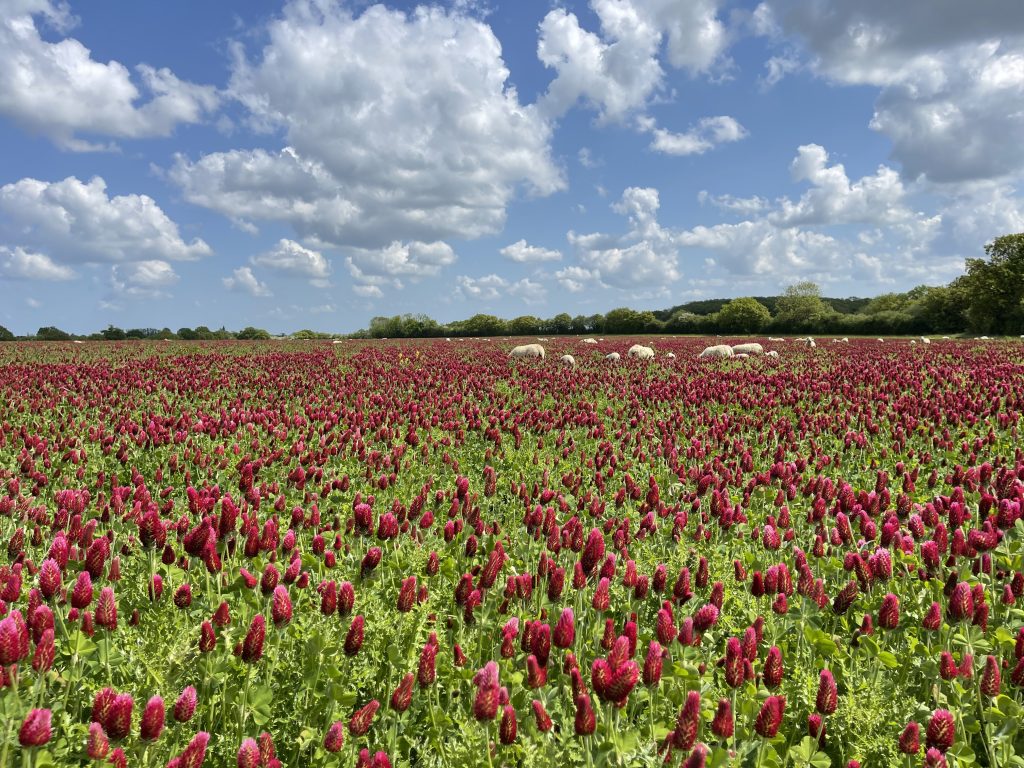
The difficulty is that we only reintroduced them in 2014, and we may have to go through several rotations to really understand what the sheep bring. With every rotation, there will be different environmental circumstances; we might have a time when we establish leys incredibly well and the sheep have too much to eat, then have a really dry spring and all the new leys are pretty poor. There are two things that need to be particularly considered when trying to work out the performance of the sheep: genetic performance and environmental performance, and it’s never consistent! At the moment (August 2024), I would say that the sheep are adding a huge amount to our business in terms of keeping our leys under control, the leys are really good, and add a great deal of biodiversity. But in a bad year with poorly established leys, over grazing happens and it’s an environmental nightmare.
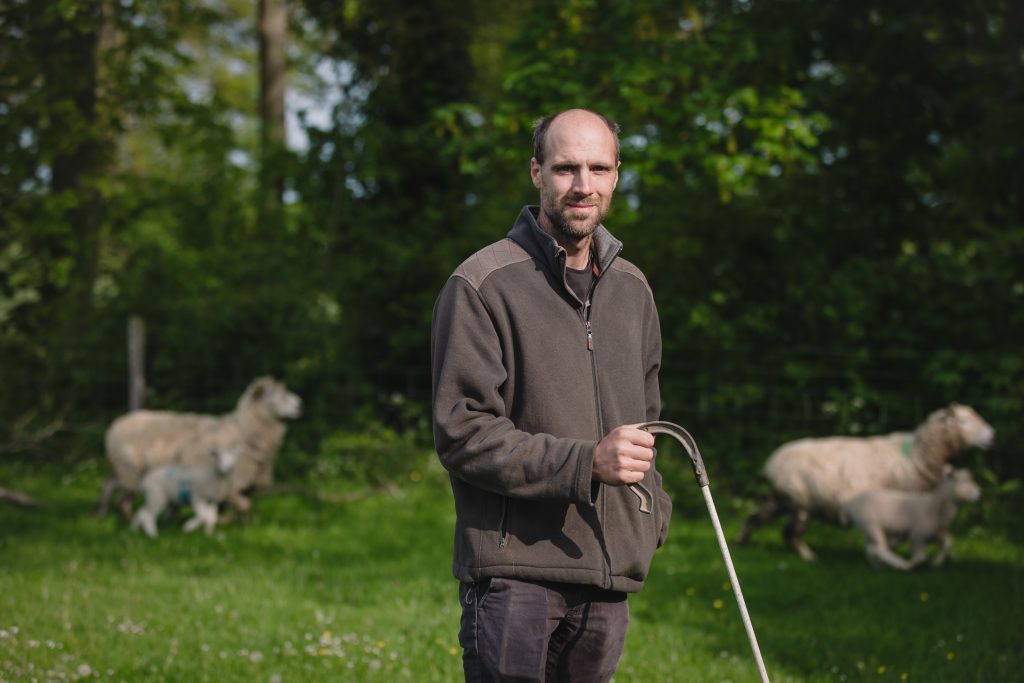
I’m still convinced that sheep have an important role to play, but if you ask me how I am judging what they’re actually bringing, it’s difficult because we’ve only really been through a rotation and half… I think we need to do 3 rotations, and then of course I’ll be dead!! You really need to be doing everything when you’re 25. The sheep have brought more people on to the farm because we have Joe, our shepherd (pictured above), who also has some part-time assistants, and the farm feels like a much busier place than it ever did, with younger people involved as well, which is very important. What I can’t say though is that sheep are brilliant, and everybody should have some!
In the video below (recorded in June 2020), John takes us on a fascinating tour around the farm. He takes us through the organic rotation including the fertility building leys and various crops grown and reasons for growing them, mechanical weeding (looking at the machinery used), why the sheep were reintroduced in 2014 and why the Romney breed was chosen. He also touches on a living mulch trial, a bean variety trial being run with PGRO focusing on reducing chocolate spot, and the net zero ambitions on the farm and sequestering carbon in the woodlands, permanent field margins and hedgerows. Working with the Farm CarbonToolkit has helped identify that the farm is currently ‘carbon negative.’
Motivations
For me (John), my family have been farmers in Suffolk for four generations, and before that farmed in Ayrshire, so there was considerable pressure for me to take on the family business! I came to the farm in 1985 when it was typical example of post-WW2 agriculture. Many of the hedgerows had been removed to make the fields easier to farm with larger machinery, as well as making way for an American bomber base. Cropping revolved around wheat, oil seed rape and sugar beet, and was stockless; the dairy herd came to an end in the 1960’s, pigs in the 1970’s.
In the mid 1990’s, I noticed some of our better soils yielding less, and some of them slumping. I had also become increasingly concerned about the amount of chemicals we were using and began to worry about their long-term impact on the soils and wildlife.
A near neighbour of mine was farming organically and I spent some time with him working out how a stockless organic rotation could run on our farm. In 1999, I converted 120 ha to organic and ran a 6-year rotation comprising of a 2-year ley followed by winter wheat, triticale, winter beans, and then spring barley under sown with another ley. Not only did the rotation do slightly better financially than the rest of the farm, along with it being a release from a high input system with costs that were increasingly hard to control, I also found it to be a much more creative way to farm.

In 2007, we converted the rest of the farm to organic production alongside other local farms we were farming for neighbours under contract farming arrangements. Our organic contract farming operation expanded, with us now farming a further 980 ha for local farmers all within a 7-mile radius of our own farm.
Although farming a stockless arable rotation had been very successful, my heart told me that we should reintroduce livestock to try and close the nutrient gap which we had been filling by importing manures and green waste. In 2014, we bought 250 New Zealand Romney ewe lambs, with a further 250 following them in 2015. We have now closed the flock and have built it to 1,000 breeding ewes which are able to make best use of our 2-year leys. The flock all lamb outside and are pasture fed, apart from the occasional winter supplement of haylage and oats, all of which are grown on the farm.
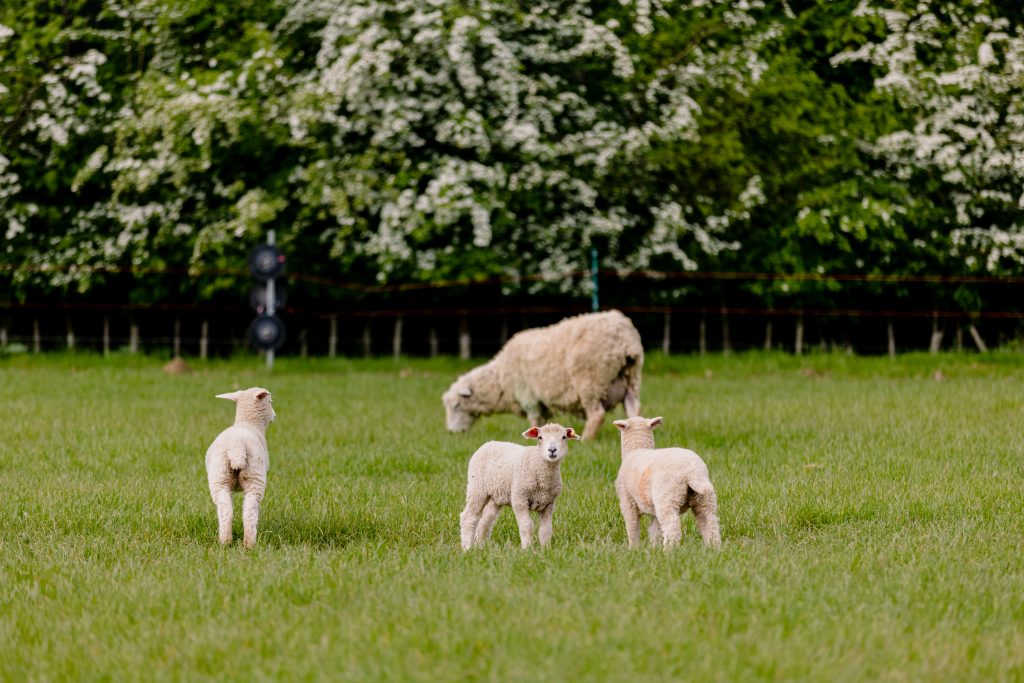
When I converted the farm to organic production in 1999, I did a soil organic matter (SOM) test pre-conversion which gave us a 2.9% SOM result. In 2016 we had tests averaging 5.5% SOM. My aims are to leave the farm’s soil in a better condition than I received it, increase biodiversity and make a profit! While soil is of course important, four key areas have come to demand equal weight: soil, nature, adaptability and people. The drivers for us are obviously profitability, but it’s also about nature recovery. It’s about farming the best way we possibly can to adapt to climate change and be part of the story about mitigating climate change. Being an employer in the village, we also feel that we have a huge social responsibility.

The podcast below includes footage of John talking with a conservation agriculture no-till farmer (Clive Bailye) from an online event ‘Know your soils and know your sales’ that took place in July 2020 as part of OF&G’s NOCC. The conversation focuses on their approaches and practices deployed to equip their farming businesses with resilience and highlights differences and similarities between the different farming approaches.
You can find out more about the Pawseys and their work at Shimpling Park Farm by watching the farm diary films and following on social media.
In this episode of the SFT podcast, Patrick Holden sat down with John and Alice Pawsey to discuss their journey from conventional to organic agriculture, their decision to reintegrate livestock, the role of farms as educational centres to help connect people with the story behind their food, and agricultural policy and what the future of farming looks like for organic farmers.
John and Alice Pawsey and family welcomed guests to the farm in July 2021 for OF&G’s National Organic Combinable Crops on-farm conference.
All images provided by John Pawsey and Shimpling Park. All Rights Reserved.


